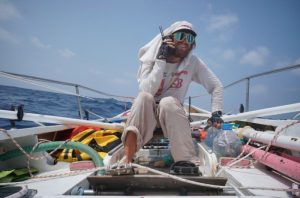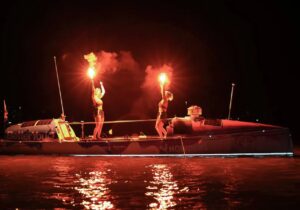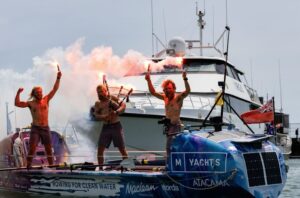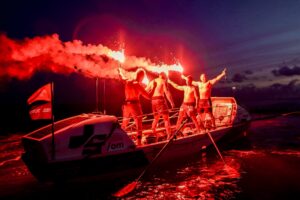Since our last ocean rowing roundup, many boats have taken to the oceans. Two races have started, one in the Pacific and one in the UK. Meanwhile, two other journeys have come to unexpected ends.
East China Sea
New Xu Fu Voyage: On June 3, Christian Havrehed and Sun Haiban started rowing from China to Japan. After three days at sea, they aborted and landed back in China.
The pair’s problems started as soon as Havrehed landed in China. Chinese officials insisted that their boat be towed into international water before they could start their journey because a rowing boat was classed as sporting equipment rather than a vessel. Then a storm held them at the start line for over a week.
On June 3, they finally began their row, setting off from Zhoushan, China, across the East China Sea to Nagasaki, Japan. But the journey was short-lived. They struggled with the wind and seasickness, covering only 100km before returning to shore. They have not said whether they will reattempt the row.
The duo first rowed together in the 2001 Atlantic Race. They were attempting this row as part of a larger project. They wanted to explore whether the Chinese could have arrived in America before Columbus. Earlier this year, Havrehed spoke to ExplorersWeb about the project.
Around the World
Ellen Falterman: Ellen Falterman’s “Ellen Magellan” expedition has ended prematurely. In May, she was making her way around the Bahamas as part of her round-the-world journey. At the end of May, she crossed the Tongue of the Ocean, an 80km stretch of the deepest water in the Bahamas. She rowed for 31 hours, crossing from Andros Island to the Exumas Islands. “Navigating it [the chain of islands] is to cruise through postcard paradise,” she wrote optimistically.
But a few days ago, disaster struck. Working her way through incredibly shallow water, her boat beached on the sand. This did not cause Falterman much stress: She had purposely beached her boat on a few occasions before in the Bahamas. Once the tide rose, she secured the boat with a bow and stern line and went onto the island to get dinner. At the time, the water was calm, with no wind.
But then a squall had arrived from the west, very unusual for the area. Falterman ran back to the boat but was too late. The waves were already smashing her boat against the rocks.
Though Falterman managed to pull her boat to a safer area, it was too damaged to continue. She wants to restart her journey but is unsure when. For now, her priority is getting home with her boat.
Pacific Ocean
World’s Toughest Row: The World’s Toughest Row race started on June 8. It is the counterpart to the company’s annual Atlantic Race. Compared to the relatively “common” Atlantic route (from La Gomera, Canary Islands to Nelson’s Dockyard, Antigua), this route sees far fewer rowers. Only 33 boats have rowed from mainland America to Hawaii.
All nine teams aim to row 4,500km from Monterey, California, across the mid-Pacific Ocean to Hanalei Bay, Hawaii. Most of this year’s rowers have previously competed in the Atlantic Race.
After a few days, the all-female Pacific Triow crew is in the lead. They have covered 325km. Charlotte Irving, Jess Goddard, and Taylor Winyard met at the Atlantic Race in 2021. At that time, they were all in separate crews, but they struck up a friendship and joined forces to take on the Pacific.
Conditions have been challenging. All nine teams have battled strong winds. Many crews have suffered from seasickness, and some oars have broken. One crew has already quit. For now, there is little distance separating the remaining crews.
Around the UK
The Long Row Home: Allan Lipp and Mhairi Ross (UK) are trying to circumnavigate Britain. On June 1, the duo set out from Wick, Scotland. They are rowing counterclockwise around the UK.
On day 10, they crossed the border into England and will continue down the east coast. The border also marked their first 200 nautical miles (370km), so they rewarded themselves with a chocolate bar. They have packed one chocolatey reward for every 200nm.
The changeable British weather has kept them on their toes. Some days start with huge swells and end with glassy water.
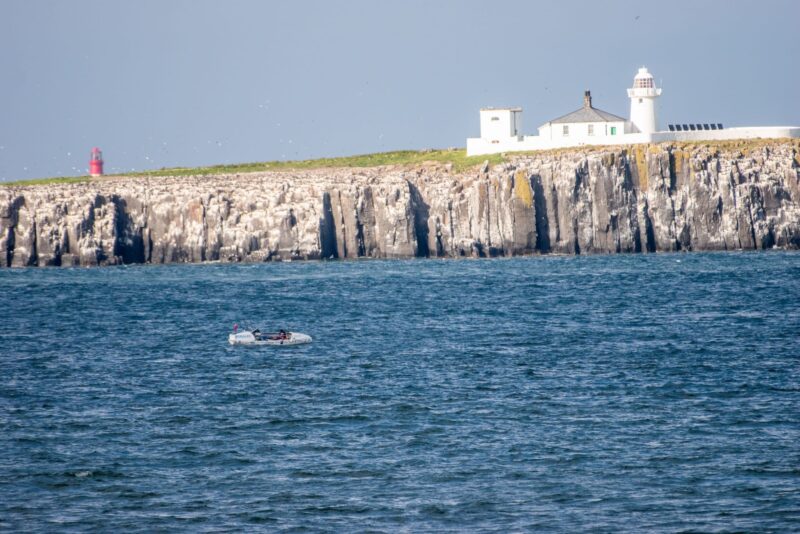
The Long Row Home team makes its way down the east coast of Britain. Photo: Stormy and Steth
GB Row Challenge: This race around the UK starts and ends at Tower Bridge in London. Teams row clockwise around the British coastline. The event first ran in 2005. It is now organized by William de Laszlo, who competed in the inaugural race.
Each team will row 3,700km around mainland Britain. With complex tides, changeable weather, and areas of heavy traffic, the row is a serious challenge.
This year, two six-person crews are racing. The first is Sea Change, an all-female crew from the UK, Canada, the U.S., and South Africa. The second is Coastal Odyssey, a mixed crew from the UK.
Since setting off on June 9, Coastal Odyssey has taken a slight lead, covering 370km to Sea Change’s 214km.


